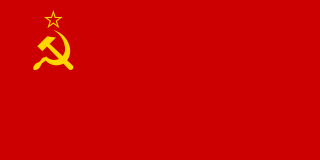
The Air Force and Air Defence, was one of three branches of the Yugoslav People's Army, the Yugoslav military. Commonly referred-to as the Yugoslav Air Force, at its height it was among the largest in Europe. The branch was disbanded in 1992 after the Breakup of Yugoslavia.

The 252nd Training Squadron is a squadron of the Serbian Air Force. It was formed in 1967 as 525th Training Squadron of Yugoslav Air Force. Based at Batajnica, the 252nd Mixed Aviation Squadron falls under the 204th Air Brigade.

The 83rd Fighter Aviation Regiment was an aviation regiment established in 1944 as 1st Yugoslav Fighter Regiment formed from Yugoslav partisan aviators on training in Soviet Union.
The 81st Support Aviation Regiment was an aviation regiment established in 1944 as 2nd Yugoslav Assault Regiment formed from Yugoslav partisan aviators on training in Soviet Union.
The 101st Fighter-Training Aviation Regiment was a unit established in 1945 as the 2nd Training Aviation Regiment as part of the SFR Yugoslav Air Force.
The 104th Training Aviation Regiment was an aviation regiment established in 1945 as 1st Training Aviation Regiment as part of the SFR Yugoslav Air Force.
The 267th Aviation Regiment of School of Reserve Officers was an aviation regiment established in 1951 as part of the SFR Yugoslav Air Force. The regiments was stationed at Pančevo and Novi Sad airports.
The 116th Fighter Aviation Regiment was a unit originally established in 1944 as the 113th Fighter Aviation Regiment. It was formed from Yugoslav partisan aviators, trained and equipped by the Soviet Air Force.
The 94th Fighter Aviation Regiment was an aviation regiment established in 1944 as 111th Fighter Aviation Regiment formed from Yugoslav partisan aviators, trained and equipped by Soviet Air Force.
The 103rd Reconnaissance Aviation Regiment was a unit established in 1947 as the Reconnaissance Aviation Regiment.
The 185th Fighter-Bomber Aviation Regiment was established in 1949 as the 185th Mixed Aviation Regiment as part of the SFR Yugoslav Air Force.
The 117th Fighter Aviation Regiment was a unit established in 1944 as the 112th Fighter Aviation Regiment. It was formed from Yugoslav partisan aviators, who were trained and equipped by the Soviet Air Force.
The 107th Mixed Aviation Regiment was an aviation regiment established in 1944 as 421st Assault Aviation Regiment.
The 105th Fighter-Bomber Aviation Regiment was an aviation regiment established in 1946 as 3rd Training Aviation Regiment as part of the Yugoslav Air Force.
The 462nd Light Combat Aviation Squadron was an aviation squadron of Yugoslav Air Force formed in 1953 at Rajlovac airfield as Training Squadron of 37th Aviation Division.
The 245th Fighter-Bomber Aviation Squadron was an aviation squadron of Yugoslav Air Force formed in 1953 at Batajnica airfield as Training Squadron of 44th Aviation Division.
The 891st Helicopter Reconnaissance and Liaison Squadron was an aviation squadron of Yugoslav Air Force formed in 1952 at Skoplje airfield as Liaison Squadron of 3rd Military district.
The 29th Aviation Division was a unit originally established in 1944 as the
11th Aviation Fighter Division. It was formed from Yugoslav partisan aviators, trained and equipped by the Soviet Air Force.
The 44th Aviation Division was a unit originally established in 1945 as the 3rd Aviation Fighter Division.
Taganrog-Central is a military airfield in the city of Taganrog, Russia. It has one concrete runway and one spare ground. Circle of flights - LR, Nkr = 500 m. Call sign (approach) - Quartet.







